Brittany
administrative region of France
Brittany (French: Bretagne, Breton: Breizh) is a diverse region in northwestern France and a historic country with a distinct identity, sharing much of its Celtic heritage with Cornwall and Wales, mostly known internationally for its crêpes.
Regions
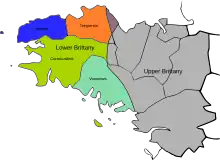
There are two regions in Brittany, which are culturally different (language, habits, dances, food, etc.):
| Upper Brittany (Haute-Bretagne) ("Breizh Uhel" in Breton) consists of the eastern part (Ille-et-Vilaine, Loire-Atlantique, eastern Côtes-d'Armor and eastern Morbihan), where the Gallo language is spoken. |
| Lower Brittany (Basse-Bretagne) ("Breizh Izel" in Breton) consists of the western part (Finistère, western Côtes-d'Armor, western Morbihan and the area around Guérande), where the Breton language is spoken. |
Departments
Furthermore, the region is subdivided into four administrative departments:
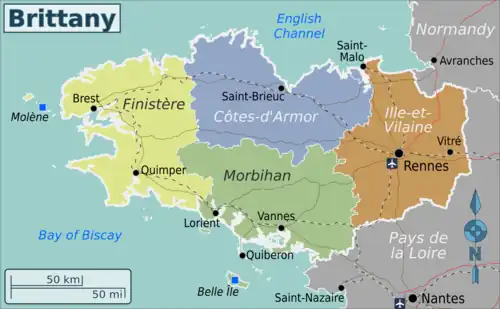
| Côtes-d'Armor Formerly known as Cotes du Nord, this department offers a rich abundance of coastal resorts, fishing ports and interior working. The interior is largely agricultural and dotted with small villages. |
| Finistère The westernmost French department; its name is from the Latin from "end of the earth". |
| Ille-et-Vilaine Named after its two main rivers, it is a slightly elevated region mostly inland. |
| Morbihan The name mor bihan comes from the Breton "little sea", a reference to the inland sea of the Golfe du Morbihan, where an abundance of wildlife thrives, together with yachts and small boats meandering between its lovely islands. |
The department of Loire-Atlantique, which has been in Pays de la Loire since the 1950s, is historically and culturally related to Brittany, and the castle of Brittany's dukes is in Nantes.
Cities
Upper Brittany
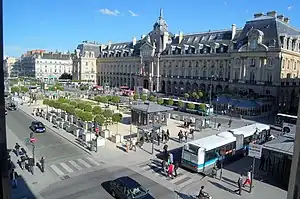
- 🌍 Rennes — The capital of Upper Brittany, a region with a unique Celtic past and culture.
- 🌍 Dinan — A medieval town popular with tourists because of its picturesque timber houses, ramparts and stone walls
- 🌍 Dinard — Regarded as one of the most prestigious seaside resorts in all of France with its international film festival, villas, sumptuous hotels, casino and an airport
- 🌍 Lamballe
- 🌍 Montfort-sur-Meu — A destination of frequent pilgrimages
- 🌍 Paimpol
- 🌍 Saint-Malo — Once the heavily fortified base of pirates and nowadays one of the top tourist draws
- 🌍 Saint-Brieuc
- 🌍 Vitré — Designated a ville d'art et d'histoire, a town of artistic and historic significance
Lower Brittany
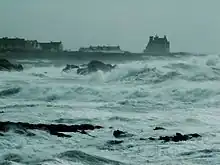
- 🌍 Brest – The quasi-capital of Lower Brittany and city with the largest tides
- 🌍 Concarneau – An old city, built by Vauban
- 🌍 Carnac – The megalithic menhirs, stones erected by the prehistoric peoples of Brittany
- 🌍 Douarnenez – A historical sardine-fishing and canning town
- 🌍 Lorient – Famous for its yearly Festival Interceltique, dedicated to Celtic music with participants from all of the Celtic nations
- 🌍 Pontivy – Popular for its castle and the Napoleonic heritage trail
- 🌍 Quiberon
- 🌍 Quimper – Capital of Finistère and famous for its Quimper faience, a type of white glazed pottery
- 🌍 Roscoff – A characteristically Breton city
- 🌍 Vannes – A city in the golf of Morbihan
Other destinations
- 🌍 Brocéliande – Arthurian forest
- 🌍 Lac de Guerlédan – An artificial lake created by EDF (an electricity utility), a scenic highlight of interior Brittany
- 🌍 Côte d’Émeraude – A verdant rocky coast stretching from St Malo to St Brieuc—bustling resorts, and charming fishing villages
- 🌍 Monts d'Arrée – A mountainous area in Finistère, with heathland
- 🌍 Trégor – One of the nicest provinces of Brittany, with the following towns:
- 🌍 Lannion – Has a cute center
- 🌍 Pleumeur-Bodou – Famous for its space and telecommunications museum and bronze-age gallery graves.
- Minor towns around Montfort-sur-Meu in the Ille-et-Vilaine department with an article on Wikivoyage:
Breton islands
Understand
.svg.png.webp)
Towards the end of the 4th century, some of the Celtic Britons from what is now Wales and southern England began to emigrate to the Armorican Peninsula. Indeed the "Great" in Britain was added to differentiate it from the "Little" Britain on the mainland. The region received its modern name - Brittany (Breizh in Breton, Bretagne in French) from these settlers. With them they brought their own customs, tradition, and language that were completely different from that of their neighbors.
As a result of their unique cultural identity, Breton history became a long struggle for independence, at first from the Franks (5th to 9th centuries), that led to a Breton kingdom. After Viking invasions the kingdom became a duchy. The influence of the Counts of Anjou and the Dukes of Normandy was important from the 10th to 12th centuries, and finally the duchy was under the influence of England and France. Brittany was united with the Kingdom of France in 1532 as a province governed as if it were a separate nation under the crown.
Jacques Cartier was a Breton sea captain who explored parts of what is now Canada in the 1530s and 40s.
The Breton people maintain a fierce sense of independence to this day, as displayed by their local customs and traditions. In 1914, over 1 million people spoke Breton which equates to 90% of the population of the western half of Brittany. In 1945, it was about 75%, and today, in all of Brittany, at most 20% of Bretons can speak Breton.
Since the 1970s, a resurgence of regional identity has happened in Brittany. Breton art, music and culture are recognized across France. It is quite common to see the Breton flag at all events, but also abroad.
Talk
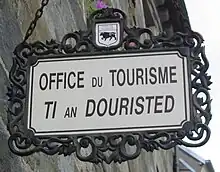
Being a part of France, French is universally spoken and understood by almost all locals in Brittany.
In Lower Brittany, many people also speak the Breton language, a Celtic language closely related to Cornish and Welsh, more distantly to Irish, and very different from French. On the road you may notice signs in both French and Breton.
While France tried to discourage the use of regional languages, their use is rebounding, bringing a stronger understanding of culture, contributions, and history. Through the local efforts of the Bretons and their Breton language schools (Diwan, Div Yezh, Dihun), children are being taught in the native language while they learn standard curriculum. The schools are supported by worldwide efforts through various groups, including the International Committee for the Defense of the Breton Language.
In Upper Brittany, the Gallo language is sometimes spoken, which is a langue d'oïl language (like French) and influenced by Breton.
Due to its proximity to the British Isles, many people working in the tourism industry can also speak English. Some British and Irish people also live in Brittany, especially in the countryside.
Get in
By boat
From various destinations:
- Channel Islands – Direct ferries from Jersey and Guernsey to Saint-Malo
- Ireland – Cork to Roscoff
- United Kingdom – Plymouth to Roscoff and Portsmouth to Saint-Malo
One of the main services is Brittany Ferries, which operates the following regular services:
By plane
There are airports in Brittany with scheduled flights:
- Bretagne Airport (BES) in Brest, served by Ryanair and Hop! - Air France
- South Brittany Airport (LRT) near Lorient, with flights from Porto and Paris
- Cornouaille Airport (UIP) in Quimper
- Saint-Jacques Airport (RNS) in Rennes, a minor international airport with direct flights from numerous French cities, Ireland, the United Kingdom and Spain
- Armor Airport (SBK) in Saint-Brieuc, with Channel island flights
By train
The TGV train runs almost hourly from Paris Montparnasse to Rennes, and then Brest, Quimper, Lannion and Saint-Malo—see the SNCF website. Some TGVs run from Lille (Eurostar connexion to London), Strasbourg, Lyon and Marseille to Rennes. There are a few TGVs that connect Rennes to Paris Charles de Gaulle Airport every day.
Regional trains also link Rennes to Nantes (via Redon or through the Pays de la Loire).
By car
Major road axis exists in the region :
- N12 - Non-tolled road linking Paris to Brest via. Fougères, Rennes and Saint-Brieuc
- A11 - Tolled motorway running from Paris to Rennes, also named the Océane Route
- A84 - Non-tolled motorway running from Rennes to Caen, the N12 merges into it between Fougères and Rennes
- N137 - Dual carriageway runs from Rennes to Nantes
To be noted, the tolled motorway A10 links Paris to Bordeaux via Nantes
By bus
Bus companies offer bus services from and to all major rail stations in Brittany.
Get around
By car
Throughout Brittany, all roads are free (no tolls).
By train
Trains are an easy way to visit Brittany, except for the center of the peninsula. There is no difference between TGV high-speed train and regional trains (TER) in Brittany—both run at the same speed, and regional trains are usually cheaper and as comfortable as TGVs.
The main regional train lines are from Rennes to Brest, Quimper, Lannion and Saint-Malo. There is also some regional services from Rennes to Nantes, and from Brest to Quimper, Quimper to Nantes, Saint-Brieuc to Dinan, Dinan to Dol-de-Bretagne. Depending on the hour, some trains have few stops, some others stop everywhere.
Regional trains are operated by the local authority. Trains, buses and some boats are operated in conjunction, often with convenient schedules for connections and combined tickets. At some hours during week days and on Saturdays, round-trips are half price (you don't pay for the way back). More information at https://www.breizhgo.bzh/en%5Bdead+link%5D
By bus
Regional buses are operated by the local authority but are under a single BreizhGo brand, so as regional trains and some boats. Buses are the best way to reach the center of Brittany where no train service exists. All these services are operated in conjunction, often with convenient schedules for connections and combined tickets. https://www.breizhgo.bzh/en%5Bdead+link%5D
See
- Menhirs and Dolmens – Brittany has a large number of megaliths, which simply means "big rocks". These menhirs (standing stones) and dolmens (stone tables) were sites for burials and worship. See some magnificent examples at the bay of Morlaix and the gulf of Morbihan. Museums at Vannes and Carnac detail the archaeological finds made at these sites.
%252C_calvary.jpg.webp)

- Coastal Brittany
- Cote de Granit Rose – The beautiful Pink Granite Coast offers an abundance of beautiful vistas, ranging from amazing pink granite outcrops through to gloriously sandy beaches.
- Cote d'Émeraude – Saint-Malo, Cancale and Dinard
- Religious buildings - Lot of churches, chapels, calvaries.
- Gardens – Brittany has exceptionally beautiful gardens, see Remarkable Gardens of France
- The chateau des Rohan in Josselin
- Nantes-Brest Canal
Do
- Participate in a fest-noz – Breton for "night fest" are dancing sessions open to everyone, where people learn to dance traditional dances from Brittany, usually from 18:00-02:00. It will cost you from nothing to €8 to participate (most of them have a €6 fee). More globally, Breton people tend to dance when they hear traditional music so you may see people dancing in the street.
- Hiking – there are many places where to hike
- Pays de Montfort – A natural and hiking destination between Rennes and the forest of Brocéliande.
- Monts d'Arrée – the mountainous area in Finistère, a very preserved place with a lot of natural paths in preserved and diverse countryside
- Biking
- Canals and some rivers have been used as communication paths since centuries. They all offer a nice way to bike in Brittany. You can go from Rennes to Dinan, Rennes to Redon and then Nantes or the Atlantic Ocean. The longest bike path on a canal is on the Nantes-Brest Canal from Redon to the Châteaudun: you literary cross Brittany east to west.
- Music festivals – There are plenty of festivals in Brittany, some of which are huge and have an international audience (Transmusicales, Vieilles Charrues, Festival du Bout du Monde, Festival Interceltique, etc.).
- Swim – Brittany is famous for beaches and
Eat
By far the foods that Brittany is most known for are crêpes and galettes among the regional specialities, that you can eat on the numerous crêperies you can find in quite every places.
- Kig ha farz – meat and stuffing
- Coquilles Saint-Jacques – famous in Saint-Brieuc
- Mussels and oysters – famous in Cancale
- Crêpes made from wheat flour, they are eaten in Lower Brittany
- Galettes made from buckwheat flour are traditionally eaten in Upper Brittany
- Galette-saucisse – a grilled sausage rolled onto a fresh galette, traditional snack in Ille-et-Vilaine, you can buy some in markets or at sportive events
- Galette complète – a galette filled with ham, cheese and an egg.
- Tourteaux (large crabs) and spider crabs
- Far breton – cake made with prunes and eggs
- Kouign amann – butter cake, served lukewarm
- Galette (biscuit) – butter sweet biscuit from Lower Brittany, not the same as galette from Upper Brittany
- Ham and pork products
- Artichokes and cauliflowers
Drink
- Cider (cidre) – Like Normandy, Brittany is cider country. Much like wine, cider comes in different varieties that are intended for different purposes, so you should pay attention to the following words on the label. Doux indicates a sweet cider, with a strong apple flavour and low alcohol percentage (3% or below), that is best drunk with dessert or by itself. Demi-sec / brut is sharper and fresher, with an alcohol content of between three and five percent. This kind of cider is more common as an apéritif, or as an accompaniment to local cuisine, especially seafood. Unlike in certain other countries, notably the United States, cider in Brittany is always alcoholic and always sparkling (pétillant). A map of the producers (in French) is here
- Perry (poiré) – Similar to cider, but made from pears. Production is considerably limited compared to its apple-based counterpart.
- Chouchen – Breton mead, a sweet alcohol made from fermented honey, water and yeast
- Beer – There is a great variety (some of them are made with sea water)
- Whisky – There are Breton whiskies. Nevertheless, there are better ones in the Gaelic world.
- Kir Breton – The local adaptation of the kir. You pour Breton cider instead of white wine, preferably from the Rance valley. (Kir, for those uninitiated, is blackcurrant liqueur and white wine.)
- Buttermilk (lait ribot)
Stay safe
When swimming in the sea, watch out for rips and undercurrents, like in the Golfe du Morbihan. Be mindful that the tide can come at a very fast pace so watch out or you might be stranded on an outlying island! Check the tides (marées) in your local tourist office. Ask for a table of the tides.
When it comes to personal safety, Brittany is fairly safe for the most part. Some larger urban areas like Rennes and Brest have their share of pickpocketing and muggings, but besides those, one can travel stress-free throughout the region.
Go next
- Channel Islands, i.e. Guernsey and Jersey
- Mont Saint Michel – In Normandy, but very close to the Brittany border; monastery and town built on a tiny outcrop of rock in the sand, which is cut off from the mainland at high tide (and then joined to the continent by a light bridge; cars and buses can no longer pass or park near the Mont, but there's a transport system with light buses). It is one of France's major tourist destinations, and as such gets very busy in high season. Check the times of the tides before you visit!